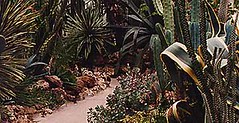The Conservatory itself has five major rooms: the Tropical House, the Desert Room, the Palm House, the Orchid House, and the Display Room. There were other rooms that held smaller potted plants such as bonsai trees and the like, but we were not required to look at those. I'll just go briefly through each room with the website's picture of each.
The Tropical House:

The Tropical House, as you can imagine, has a lot of tropical plants and trees. Some noteworthy plants included the vanilla plant, the cacao tree (mmm...chocolate), sugar cane, papaya, fig tree, and lots of hibiscus flowers. Almost all of these plants are only grown in warm, moist climates, such as in Florida and the tropics. There weren't too many flowers in bloom, but the ones that were blooming were vivid and beautiful. The colors ranged from bright pinks to dark reds, and even blue and purple. The plants ranged in size from low to the ground to reaching all the way to the ceiling. Oh, and because these are all tropical plants, it was quite warm and moist in that room. This even allowed us to shed our winter coats!
The Desert Room was quite a change coming from the Tropical House. In contrast, it was quite dry and stuffy in that room, but these plants flourished just as well as those in other rooms. The typical desert inhabitants such as cacti were in there, but also some plants with very elaborate leaves. The only different between these and other leafy plants is that the leaves are stiff and thick in order to conserve water. Also, a lot of the plants had spines or "pricklies" as leaves to prevent water loss in the dry environment. There were some flowers present, and they were just as bright and vivid as those tropical plants. It really was surprising that such beauty can grow in such harsh environments.
The Palm House: 
As you can probably imagine from the name of the room, the Palm House contained those trees you in Florida and California are familiar with: the palms. However, this room also included flowering trees and non-palm trees that grow in similar habitats. The tallest tree in there was the Florida royal palm, which practically touched the 45 foot-high ceiling. There were fern palms, "pine" trees, begonias, coffee trees, a coconut palm, and even a banana tree with REAL bananas growing! These plants are some of the species found in the tropical rain forests, so there was also some information about the rain forests themselves. We found out that they only habitate 8% of the earth's surface, but contain 50% of all plant and animal species. This is only one reason why the rain forests are so important, and why conservationists are so adamant about saving them. At the end of the room there was a giant waterfall, which really was spectacular. Some of the plants had to grow near the water, and there were even some of the plants that grew IN the water. This really shows how important water is in these ecosystems.
The Orchid House:
I don't have a picture of this house since it's pretty new to the Conservatory, but I'll try to describe it for you. Orchids are some of the most numerous flowering plants, so there were dozens of different plants. There were different colors everywhere, almost covering the entire visible spectrum: red, orange, yellow, blue, purple, and white. These plants also require a lot of water, so this room had running water in it. One interesting fact that we found out was that the Conservatory is a storage center for endangered plants for the government. They even collect confiscated plants from airports, etc. when people try to bring them illegally into the U.S. It was a really colorful room, and even smelled good, too.
The Display Room: 
The Display Room was another of the rooms we didn't have to look in, but we were encouraged to view it anyways. They change it from time to time depending on the time of year, and although I don't have the current picture, I'm sure you can imagine what is in there now. Any takers? Well, it was decorated with Christmas-related plants like poinsettias and lilies, and not to mention a Christmas tree or two. It really was very nice and along with the music in the background, got me into the spirit of the season.
Well, that concludes our trip to Krohn Conservatory. If you want to find out more (and why wouldn't you?), just click on the link I placed in my first sentence of this post. That's really all I have to say for now, but I'm sure I'll have plenty to talk about at the end of this week. I hope everyone is doing well, and looking forward to Christmas like I am.


4 comments:
I couldn't get a couple of the pictures to load, but I'll upload them as soon as I can figure it out.
What comments did your Mother make on this entry?
I'm going to ussume that the Palm House also has running water.
There is a rule, nay a law, that states that if you use the word 'waterfall' there must be a picture.
I finally got the pictures to load. I found out it was because I needed to align them to the right or to the left instead of the center like I had been doing. Oh well, but at least they work.
Grandpa, what do you mean about my mother's comments?
And Marty will be pleased to note that the Palm House section now has a picture of the waterfall.
Post a Comment